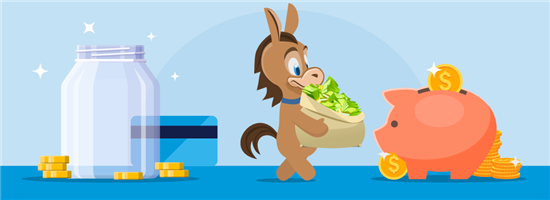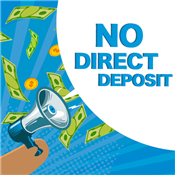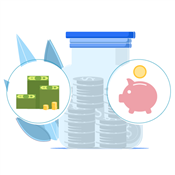Can You Direct Deposit Into a Savings Account
Learn whether you can direct deposit into your savings account, the benefits of direct deposit, and how to sign up.
 |
You can set up direct deposit to go to your savings account.
But should you?
Find out the surprising reasons why it may be a good idea, how to set it up, and more in this guide.
Can You Direct Deposit into a Savings Account?
Quick answer: Yes.
While most people forward their entire paycheck to a checking account, there is no legal requirement or workplace regulation to do so.
You have the choice to deposit all, or a portion of, your paycheck deposited into a savings account if you wish. Maybe people even choose to split the paycheck between a savings and checking account.
Now that you know you can direct deposit into your savings, let's take a look at whether you should.
Yes. You can set up direct deposit into your Cash App account for up to $25,000 per individual deposit and up to $50,000 in a single day. [1]
Should You Direct Deposit into a Savings Account?
Traditionally, your checking account acts like the central train station between your bank accounts.
Money comes inbound to your checking account in the form of paychecks and other income — and money goes outbound from your checking account to use for expenses like bills and spending money.
3 Reasons to Direct Deposit into a Savings Account
There are some good reasons to consider sending part of your paycheck into a savings account.
- Automate savings and eliminate the need to transfer money between accounts
- Savings earn interest, while your checking account (most likely) does not
- May incentivize savings because you won't see your full paycheck as "spending money" each month
Before determining how much money to deposit into your savings account, make a budget to ensure you will still have enough money in your checking account to cover all necessary expenses.
Another smart reason to send a direct deposit into a savings account is if you have a second job or side hustle for the specific purpose of saving more money while your primary job pays for all your expenses.
In this case, it makes sense to send your entire paycheck from the second job into your savings account.
How to Direct Deposit into a Savings Account
To adjust or set up a direct deposit into your savings account, follow these steps:
- First, notify your payroll department
First, tell your boss, payroll manager, or whoever handles your payroll information that you would like to amend your direct deposit to include your savings account. Request a direct deposit enrollment form. - Then, fill out the direct deposit enrollment form
Next, fill out the form. You will need to include your name, Social Security number, signature, and date. You will also designate the bank name(s), account type(s), account number(s), routing number, and the amount you would like deposited into each account. - Finally, submit the form
Last, submit this form to your payroll manager. Note that it may take one pay period for your new direct deposit information to process, so the changes may not be reflected on your next paycheck.
If both accounts are with the same bank, the routing numbers are likely the same. Routing numbers identify the banking institution, while account numbers identify a specific account. However, some large banks have multiple routing numbers, so it's best to double-check.
What is Direct Deposit?
Direct deposit refers to the automatic electronic transfer of funds from a sender directly into a recipient's bank account.
It's usually used for workplace payroll, but can be used for other payments as well, such as your annual tax return.
Direct deposit allows you to get paid and use funds faster. In the old days, an employer would give you a paper check on payday. Then, you'd have to manually deposit into your bank account by visiting a branch.
With direct deposit, your employer's bank and your bank communicate directly through a network called the automated clearing house (ACH) so that you get paid in the early morning on payday (and in some cases, up to two days before payday).
Direct deposit also reduces potential human error because there are fewer forms, deposit slips, and person-to-person interactions taking place.
Why You Should Participate in Direct Deposit
Still using paper checks to get paid? There are many reasons why it is beneficial to participate in your workplace's direct deposit program, including:
- Speed
As mentioned above, direct deposit is much faster than the alternative — and who doesn't want to get paid faster?What time do direct deposits post?
Usually very early in the morning on the date of payment. For example, Chase direct deposits go through between 3AM and 5AM, Bank of America between 4AM and 6AM, and Wells Fargo between 12AM and 3AM.[2] - Convenience
Cashing checks requires a lot of time and effort. Traveling to the bank, standing in line, filling out a deposit slip … you get the picture. Eliminate the hassle with direct deposit. - Security
Direct deposit eliminates the risk of a check being lost in the mail, stolen, or cashed by a thief. Digital payments are also encrypted. - Reduced Waste
Since neither you nor your employer needs to print or file paper documents like paystubs, you can help cut down on clutter and waste by signing up for direct deposit.
The Bottom Line
Yes, you can direct deposit your paycheck into a savings account. It is recommended to only deposit part of your pay into savings while sending the majority to your checking account to use for necessary expenses.
If you would like to make direct deposits into your savings account, speak with your payroll manager to learn the specific steps you need to follow at your workplace.
References
Write to Justin Barnard at feedback@creditdonkey.com. Follow us on Twitter and Facebook for our latest posts.
|
|
|




